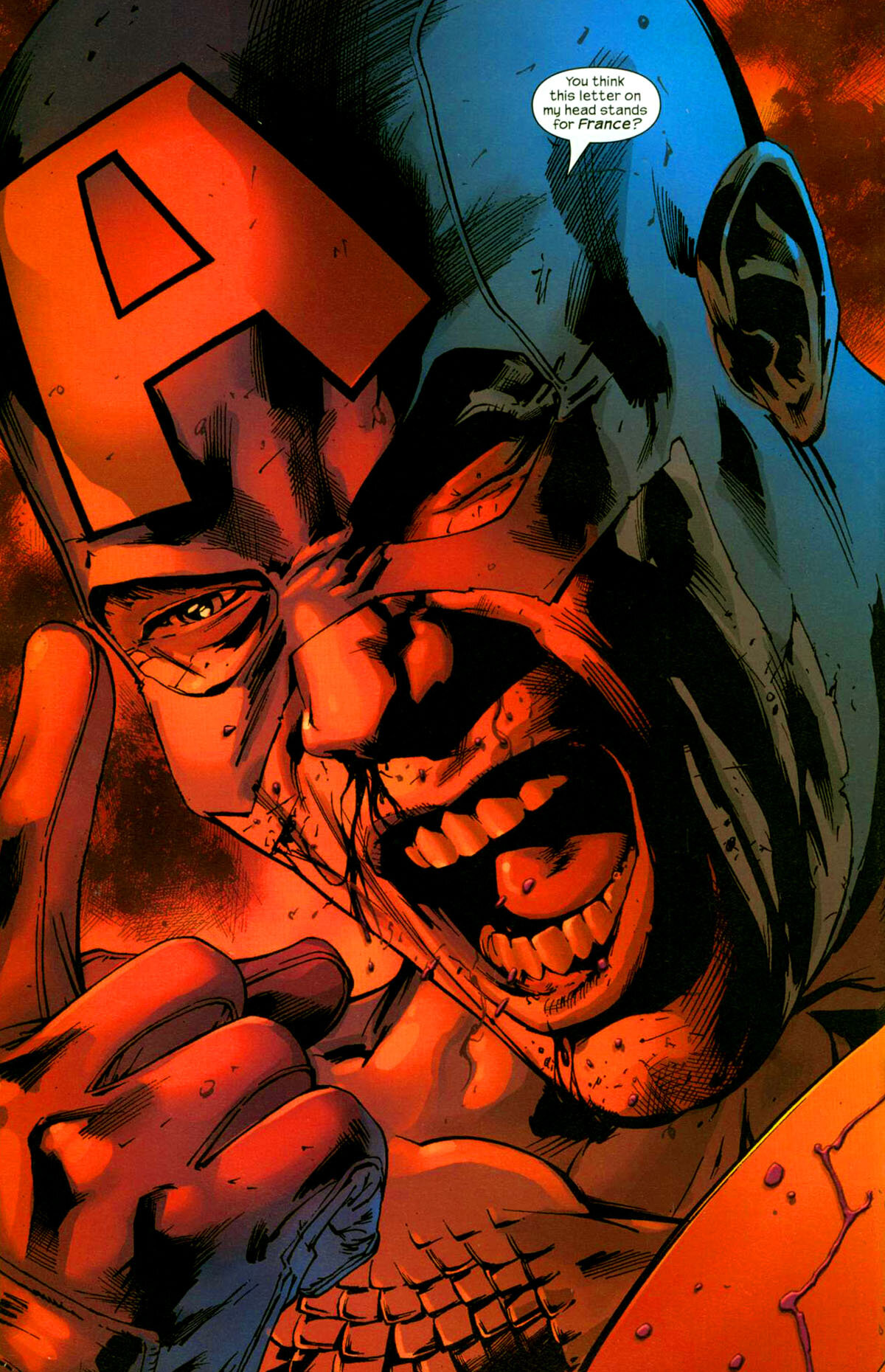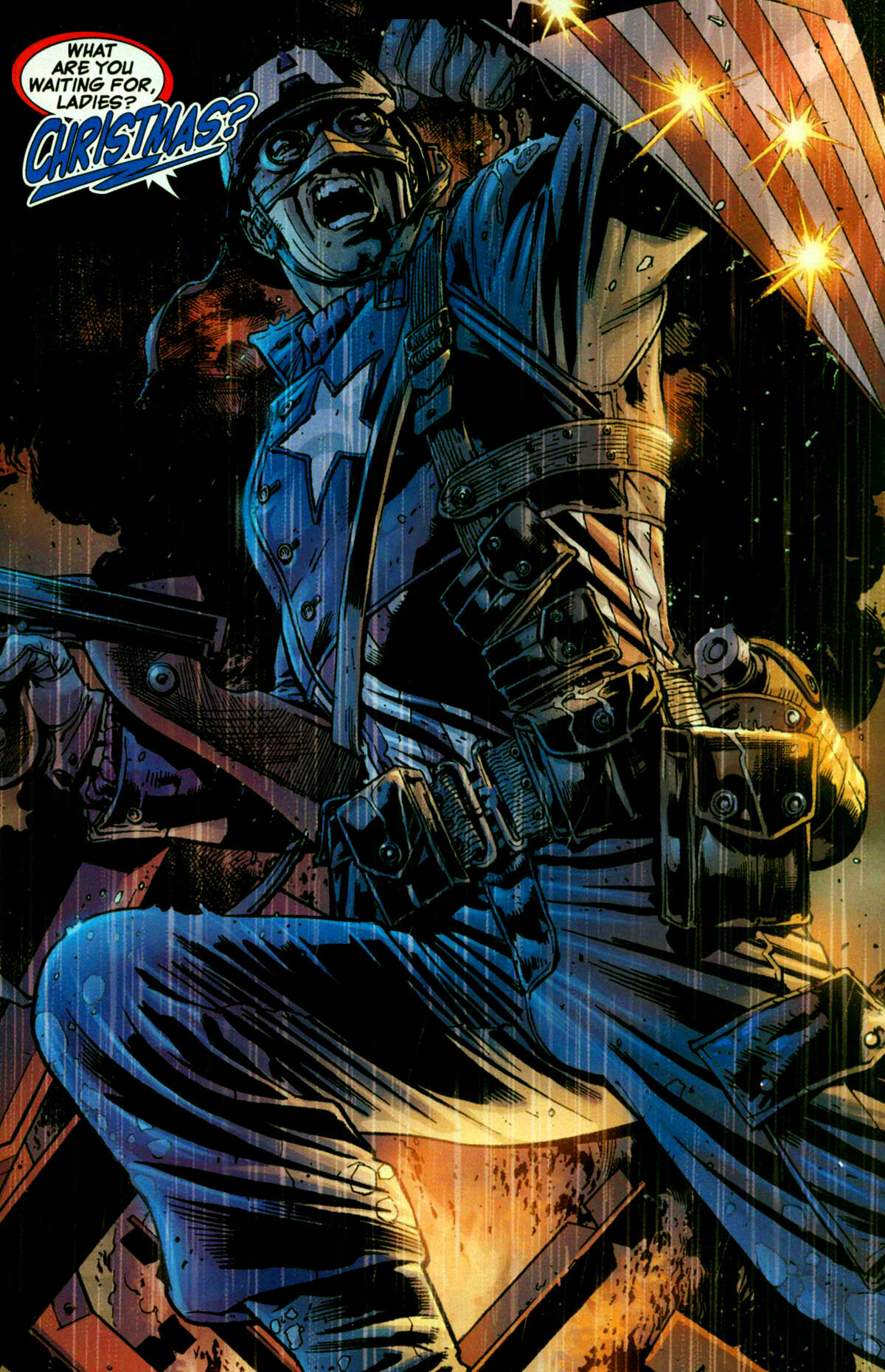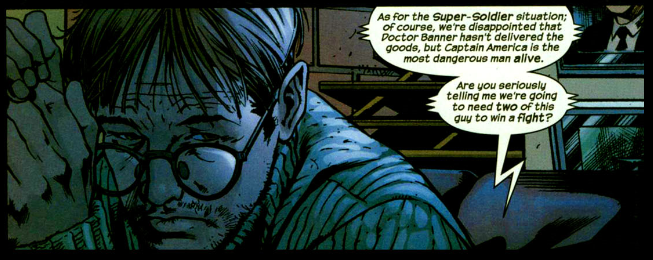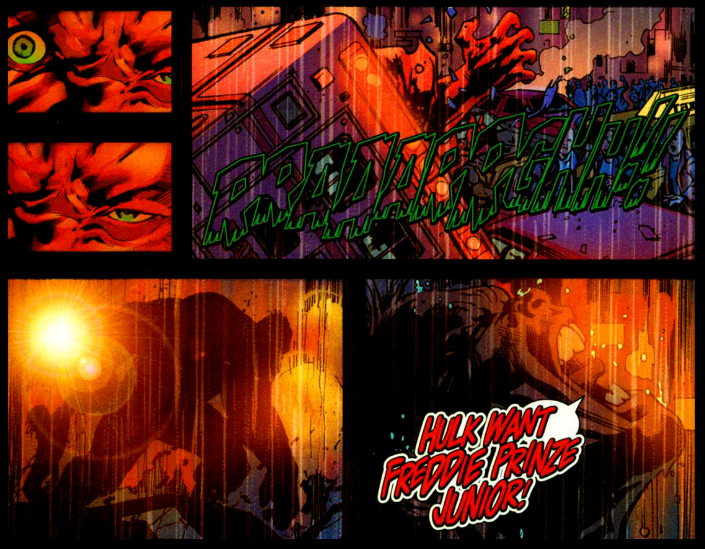We Need To Talk About the Ultimates / The Ultimate Universe at 20
With the Ultimate Comics line from Marvel hitting 20 years old, we at YRDC thought it would be a good idea to look back. The Ultimate Universe line may have ended, but it is still considered a great jumping on point for many fans. The Ultimate Universe has also strongly influenced multiple record-breaking movies and even started a legacy for Spider-Man that doesn't feature clones. Surely, these books should have aged well, yes?
As we saw last time, the Ultimate Universe began slowly. Brian Michael Bendis introduced the world to the new Ultimate Spider-Man, updating Peter Parker's origin for the 2000s. Mark Millar would also update Marvel's best selling X-Men books for this line, adding a political slant to comics that (if you believe some people) were never political for books about a marginalized minority hated by the populace.
As 2002 rolled around, the world genuinely felt like a darker place. September 11th, 2001, had left a scar on the psyche of the American public that would result in decisions both troublesome and well-intentioned (not always at the same time). The American public's tastes would also change, asking for more "realistic" entertainment in a world where terrorists felt like they could be around any corner. Comics would also evolve to meet this desire, and the early attempts at realism were fumbled and often ham-fisted.
Case in point, 2002's Ultimates.
Ah, 2002. When America was psychotically paranoid about being PATRIOTIC.
Oh, boy. We… we need to talk about the Ultimates.
With a popular comic in the Ultimate X-Men, Mark Millar was given a chance to reinvent the Avengers for this new comic line. Brian Michael Bendis was busy with Ultimate Spider-Man and Daredevil, and Millar had an idea for the angle he would take on the book. As we discussed before, the point of the Ultimate Comics line was to boil characters down to their base core ideals and expand from there. Millar would speak with Comics Bulletin about his idea years later as such:
"You have to approach it as though nothing has happened before and tell the story fresh from the start … We had to get to the core of who these people were and build outwards, so Cap was a soldier, Thor is either a nut case or a messiah ... Banner an insecure genius, and Fury, the king of cool."
Fans of Marvel Comics might notice a few problems with this. No one in the original Marvel Universe ever questioned if Thor was really a God nor not, though that might have been because of storytelling techniques of the day. While Captain America was a soldier in his first stories, that was never the core of his character after being revived in the 1960s. There would be other questionable decisions made by Millar as the comic rolled on, and we will have to discuss these in turn.
The first issue of Ultimates was released in March of 2002, with a ton of fanfare and house ads galore. While Millar worked on the story, Bryan Hitch provided the pencils and was inked by Andrew Currie. Paul Mounts (with Bontogone) provided the colors, and Chris Eliopoulos provided the lettering. What results is one of the most… uniquely aged comics in Marvel's history.
Issue one opens up in 1945, with Captain America's final mission from World War II. The biggest change from page one is that Captain America's sidekick Bucky has been aged up and given the rank of Corporal, and a photojournalist making sure the propaganda machine for America is still rolling. While the book does a solid job introducing the point of view of the average joe involved in combat, there are some weirdly off lines about Millar's Captain America versus, say, Stan Lee's Cap.
Unfortunately, rather than focus on the man who became a soldier through necessity and doing what's right, Captain America is instead a Steven Rogers who oozes toxic masculinity. That isn't to say this, Steve Rogers doesn't do good things, or isn't potentially a good person. However, comparing normal men to "girls" and later comments made by this version of Cap put him plainly on the other side of the "does Millar understand this character" fence. When looking at the first Captain America movie from 2011, it's plain to see that lessons were learned with this interpretation of Captain America. And, unfortunately, it does get worse.
However, that's not to say the first issue isn't all gloom and doom looking back. The man flies what appears to be a Douglas XB-19 heavy bomber into a heavily fortified Nazi fortress to break a hole in the Nazi defenses. The two page sequence is incredible, and is actually one of the best moments of the entire series. Admittedly, it fuels Captain America into being more of a hyper-macho movie hero than a person behind the shield, but it works incredibly well. Cap also has a fiance he plans to marry once the war ends, a woman named Gail. Since the book hasn't been quiet about Cap being in the present day on the cover, it adds some decent pathos to be used later.
Also, Germany has an experimental hydrogen bomb.
...which is an advanced form of the atomic bomb, according to my research. Which Millar possibly didn't do, seeing how you kind of need to have atomic bombs to make the hydrogen versions, the first H-bomb came around in the 1950s, and the term is used interchangeably here with Atomic weapons. It is possible this twist is intentional, as the big reveal is that aliens have been helping the Nazis (spoilers, I suppose, for a comic that's 18 years old). Still, Bucky somehow knows we're working on an identical top-secret project in New Mexico.
Considering I grew up in a city founded by the Manhattan Project (Richland, Washington), little things like that really stuck out to me, even back in 2002.
Anyhow, the missile explodes after Cap is able to sabotage it, and sends Cap flying into the icy seas below.
The rest of the comic after issue one is broken up into mini-arcs as the story progresses. Issues 2 and 3 are used to introduce the rest of the main cast. Nick Fury, Bruce Banner, the Pyms, and more. The lion's share of characterization and development is given to Steve Rogers as he tries to adapt to this new world he wakes up in. Contrary to earlier complaints about this Cap, Miller is able to write him as genuinely human in these pages, and it almost feels like he's course-correcting from the first issue.
Issues 4 and 5 feature Bruce having a Hulk attack, and the Hulk threatening Manhattan. The Ultimates assemble to take him down, and the resulting mashup causes the team to get closer together, with Thor swooping in for a save at the end.
However, 6 through 9 introduce one of the worst parts of the story: Hank Pym, spousal abuser. After an argument with Jan where Hank shows how jealous he is of almost literally everyone else, and showing a bigoted side of himself because Jan is also now a mutant, Hank decides to have his ants assault Jan, putting her in the hospital. Captain America then hunts down Pym and pummels him senseless because he is a man, and man must protect woman.
And then they fight Nazi aliens in the last four issues, which feels like it came from another comic entirely.
Needless to say, there is a lot to unpack here.
While Tony Stark did show up in Ultimate Team-Up issues 4 through 6, this is an entirely different looking Iron Man. The armor is more like the armor Master Chief uses in Halo: bulkier and larger. Tony is also an open boozehound, much like his MCU incarnation from a few years down the line.
This is past the origin point for Tony becoming Iron Man. Not only does he have the armor, but Tony has been working as a force for good for quite some time now. Millar does reveal what caused Tony to become a hero: he has found an inoperable cancer lodged deep in his brain, and wants to leave a better legacy. Tony remains a static character throughout the book, aside from this, but he is a welcome anchor point throughout the insanity of the Ultimates.
It is also possible that Marvel wanted someone else to tell his full origin story, leaving the explanation as an off-hand remark for now. In fact, science fiction author Orson Scott Card would be recruited to tell the origin story, which would be published across the years of 2004 to 2008. And then basically ignored, because Card would argue that Stark is a brain-person made of super-regenerating flesh and that is why he is the only person who can take being in the suit. The Ultimate Universe can only be so weird, it seems.
Bruce Banner starts off the book as a pure scientist and support character, with his Hulk days in the past. Fury brings him on with the intent of re-creating the Super Soldier Serum that made Captain America. However, the discovery of Captain America frozen in ice, along with nearly every other member being either a smarter super scientist, or a superhero, or both drives Banner into despair. This isn't helped with his ex-wife being his handler, and nearly everyone ripping into Banner when they get the chance.
Being put down by your boss on national television. There is a reason the Ultimates received the nickname "what if the Avengers were assholes" in the online fandom at the time.
Bruce snaps and actually walks into the middle of NYC before injecting himself full of Hulk serum. It's played for drama and positioned like the reader should be disgusted at Banner for making such a poor choice. However, when someone like Banner is literally trapped at gunpoint in a toxic workplace, it's hard to see Millar's point. It's still a bad decision, but it's hard to see Bruce as the real bad guy here.
And then there's the Hulk.
I genuinely do not know where to begin with this. The core aspect of Hulk is a misunderstood being who wants to be left alone, no one leaves alone and handles this with anger and punching. The Hulk of the Ultimate Universe, however, is an amplified toxic male who stalks his ex-wife and is horrified at the idea of being anything less than macho and straight. And this is generally played for laughs rather than drama.
The fact that Cap is gay-baiting Hulk does not help things.
Oh. And when she sees the Hulk devour an alien being in an act of savage cannibalism, his ex-wife is turned on by this.
No. I am not joking.
Hank and Jan Pym are the… most troublesome aspects of this book. Hank Pym has a difficult past in the main marvel books, to begin with, thanks to writers and artists not communicating, resulting in the first heroic character to also beat his wife while having a massive mental breakdown.
However, it seems like this was all the characterization that Millar found during his research or all he cared about. Pym is a fragile man, and the only one really wanting to engage in the Ultimates project as a hero until the Hulk incident. He's then resoundingly pummeled by the grey ball of rage, and then decides to have his ants assault his wife after a bad argument.
This had a side-effect of turning Hank Pym almost entirely into "the hero who beats his wife," no matter the continuity. It also doesn't help that Millar chose to turn Jan into a mutant, using that as part of Hank's bitter argument with Jan, leaving him also coming off as a racist at the same time.
Jan is a mostly static character herself, basically feeling like a prop during this plot to advance Captain America's character and also turn Pym into the villain for that micro-arc. Luckily, she is more of a character outside these pages, dealing one of the stronger blows against the Hulk and helping the Ultimates fight off aliens from inside their base. It just… feels like the Pym arc dominates much of her page-time instead. And it doesn't help that she falls for Captain America at the end of the book.
Apparently, beating up their husband and abuser just totally makes someone fall for you.
Thor is the only other major character to be on the page, with almost all of his page time dedicated to questioning if he is really a God or some crazy man with high technology on him. Thor himself has less development than he was given in the Avengers movie, with his most defining moments being a smirk aimed at the reader when his Godhood is questioned. This series also acts as Thor's introduction to the Ultimate Universe, and it plays well for the angle Millar was aiming for. However, it also undermines the character when most of his on-screen action is "being played as a joke."
Hawkeye and Black Widow do show up, which seems to have nailed them being included in the Avengers movie down the road. However, they come into the book incredibly late and barely have any lines to speak of. Their personalities are also that of one-note cardboard, which makes them feel like props for the other heroes.
Oh. And despite being villains at the time, Quicksilver and the Scarlet Witch are here. And do nothing on the page.
The other really weird thing goes with the fact that the aliens who invade were also the Nazis who we fought in World War 2. They're the Skrulls, for those familiar with the recent Captain Marvel movie or older Marvel. They're blamed for almost every aspect of the war, except for the Holocaust and Death Camps run by the Nazis. The book calls this out as trying to give Captain America "closure," but it really feels more like Millar ran out of ideas and started throwing darts at a wall until he had a plot for the final 4 issues of the book.
The art, I must confess, is actually excellent overall. Bryan Hitch brings the Ultimate Universe's signature gritty realism in his pencils. However, the leather costumes feel distinctly mid-2000 thanks to pop culture like the Matrix and X-Men movies influencing comics heavily at the time. Paul Neary's inks work well with the art, adding to the realism and clarifying some of the art.
Unfortunately, the color palette chosen for much of the books has this tendency to fall incredibly flat. Paul Mounts does an excellent job of choosing colors for what would be real-world settings. Daylight scenes are nice as well, with realistic colors that can still be bright. However, the choice of making the Hulk a flat gray turns the entire Hulk fight and grand finale of the book where the Hulk takes on a bunch of gray alien warships a fantastic mess of monotone shades with flame highlighting.
Should you check out the Ultimates today? Honestly, probably not. The book was stripped of its best aspects and combined with classic Marvel to give us 2011's Avengers movie. They even found the name of the aliens here: the Chitauri, another name the Skrulls use. What remains in the book that would be new to most readers can be considered to be genuinely some of the most toxicly bad comic content this side of the year 2000.
Hawkeye and Black Widow have become household names thanks to those movies, making their general shortage of characterization here utterly lackluster by comparison. Chris Evans' interpretation of Captain America makes this one feel like a poor imitation trying too hard to be Cap at times. Still, you can also see the source for some of the quieter movements of the character in those movies.
Other characters like Hulk and Iron Man are the same in name only, with almost all aspects of their characterizations feeling just close enough to feel incredibly wrong. Even the Nick Fury characterization feels like a bad movie stereotype rather than the deep Nick Fury from Ultimate Spider-Man. Hank Pym was given the death knell with this comic, and while he has continued to exist in the canon of Marvel since 2002. Nearly all of his appearances since have addressed or referenced him as a wifebeater. This comic was the same as the main Marvel canon. As such, when it came to the movies, Marvel wisely side-stepped him entirely and chose to run with second Ant-Man Scott Lang for their main movie character.
Look. It's worth looking back at older comics to learn from the mistakes of the day and enjoy what was truly good, don't get me wrong. Ultimates, however, almost belongs in the dustbin of history without being given a second glance.
Yes, it helped reinvent the Avengers for a post-2001 world.
But the 2011 Avengers movie did it better, and without being mean-spirited or toxic.
Issues covered this chapter:
The Ultimates 1-13
Total issues covered so far: 76
In our next chapter: We branch out into the rest of 2002 through 2004. While Spider-Man and X-Men continue, a bunch of smaller books also join in fleshing out the Universe. Also, the Fantastic Four!


















